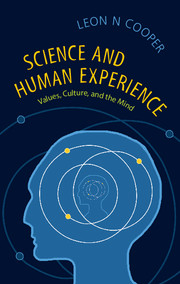Book contents
- Frontmatter
- Dedication
- Contents
- Preface
- Acknowledgement
- Part One Science and Society
- Part Two Thought and Consciousness
- Part Three On the Nature and Limits of Science
- 19 What Is a Good Theory?
- 20 Shall We Deconstruct Science?
- 21 Visible and Invisible in Physical Theory
- 22 Experience and Order
- 23 The Language of Physics: On the Role of Mathematics in Science
- 24 The Structure of Space
- 25 Superconductivity and Other Insoluble Problems
- References
21 - Visible and Invisible in Physical Theory
from Part Three - On the Nature and Limits of Science
Published online by Cambridge University Press: 05 November 2014
- Frontmatter
- Dedication
- Contents
- Preface
- Acknowledgement
- Part One Science and Society
- Part Two Thought and Consciousness
- Part Three On the Nature and Limits of Science
- 19 What Is a Good Theory?
- 20 Shall We Deconstruct Science?
- 21 Visible and Invisible in Physical Theory
- 22 Experience and Order
- 23 The Language of Physics: On the Role of Mathematics in Science
- 24 The Structure of Space
- 25 Superconductivity and Other Insoluble Problems
- References
Summary
How is it that physicists can invent equations, so rich in structure, so detailed in consequences, and so closely in agreement with experience? What does it mean when we create equations that agree with experiment to ten decimal places? Do these equations have a reality of their own?
This essay is based on a lecture originally presented at the Trieste conference in honor of Paul Dirac in 1972.
It is more than fifty years since Paul Dirac gave us one of the most beautiful inventions of the twentieth century:
H = ca · p + βmc2
I once asked Professor Dirac how he came upon his masterpiece. If my memory serves (I hope he will correct me if it does not), he said that in the late 1920s most physicists, trying to calculate with relativistic quantum mechanics, were content to use the Klein–Gordon equation modified with ad-hoc corrections. In his attempt, Dirac did not try to put in the electron spin but rather to treat in a consistent manner the simplest possible problem: that of a spinless, relativistic electron. The critical moment came when he realized that 4 × 4 matrices were required. “How long did it take you from that point?” “About two weeks”. I couldn't refrain: “why so long?” He was a bit taken aback; then, his attention focused perhaps on those two glorious past weeks, he nodded as though to agree in silence why so long?
- Type
- Chapter
- Information
- Science and Human ExperienceValues, Culture, and the Mind, pp. 170 - 176Publisher: Cambridge University PressPrint publication year: 2014

